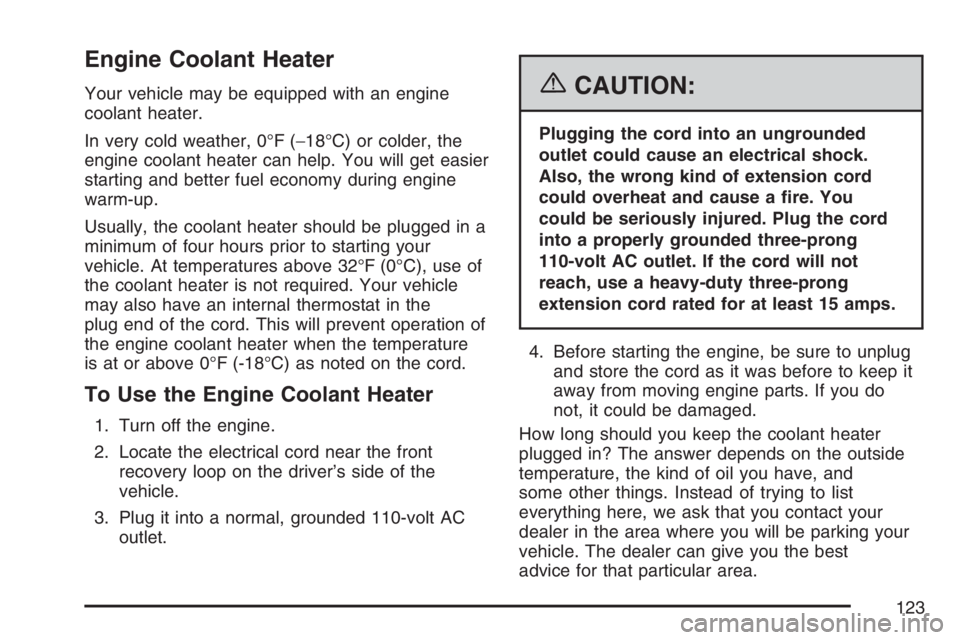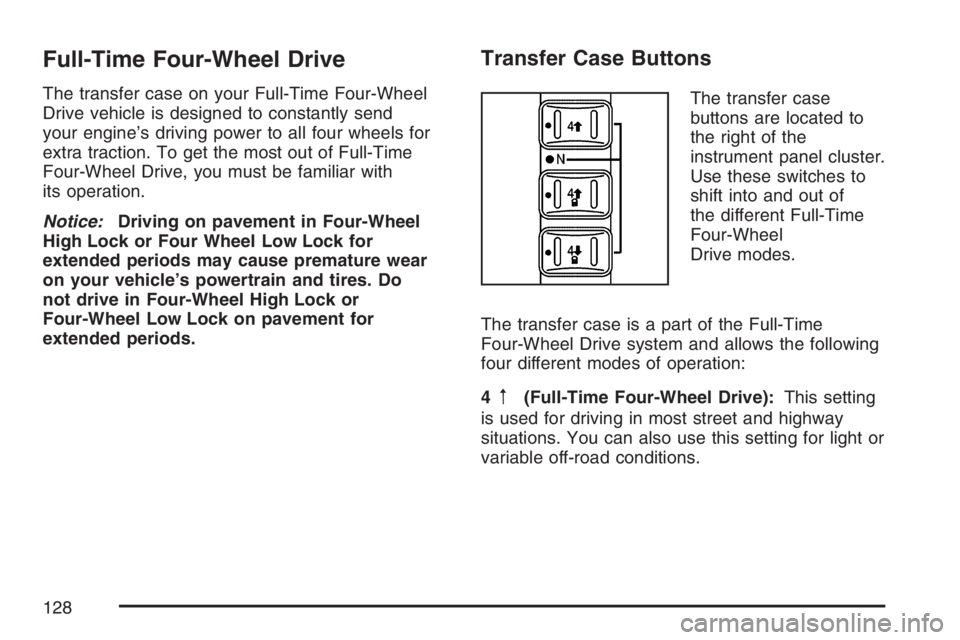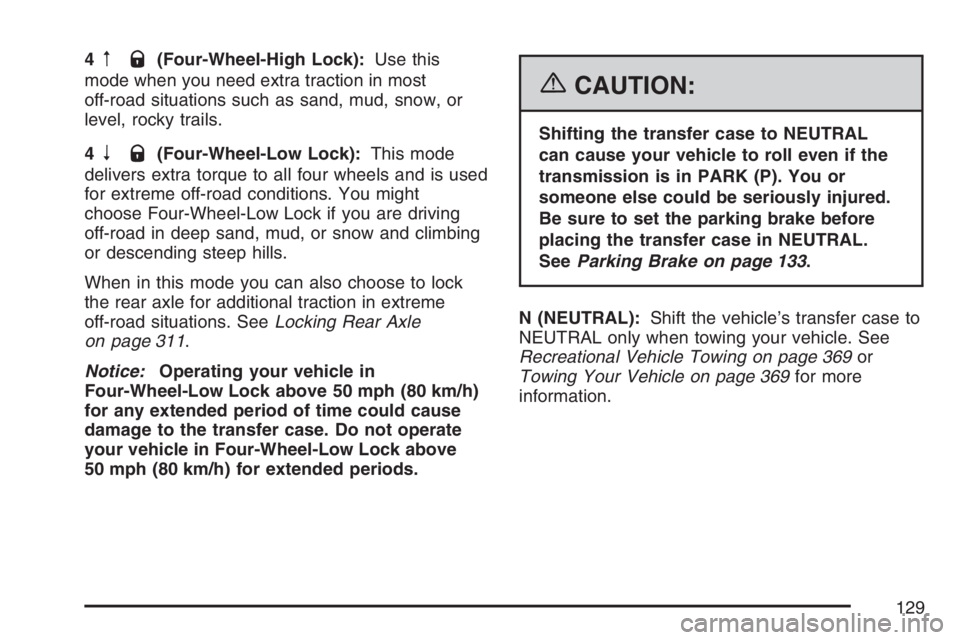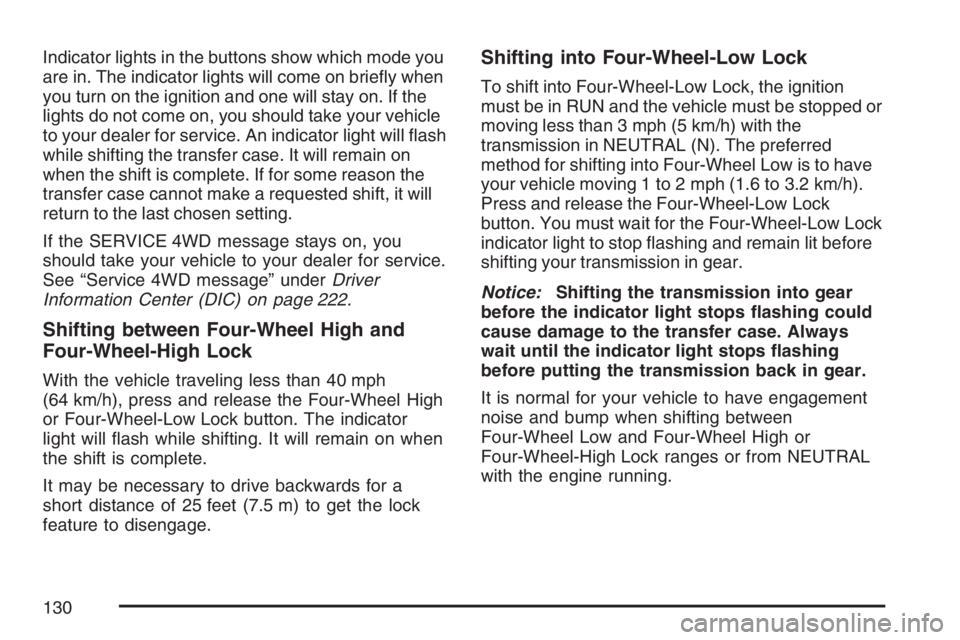HUMMER H2 2007 Owners Manual
Manufacturer: HUMMER, Model Year: 2007, Model line: H2, Model: HUMMER H2 2007Pages: 570, PDF Size: 3.34 MB
Page 121 of 570

Key In the Ignition
Never leave your vehicle with the keys inside, as it
is an easy target for joy riders or thieves. If you
leave the key in the ignition and park your vehicle,
a chime will sound, when you open the driver’s
door. Always remember to remove your key from
the ignition and take it with you. This will lock
your ignition and transmission. Also, always
remember to lock the doors.
The battery could be drained if you leave the key
in the ignition while your vehicle is parked.
You may not be able to start your vehicle after it
has been parked for an extended period of time.
Retained Accessory Power (RAP)
The Retained Accessory Power (RAP) feature will
allow certain features on your vehicle to continue to
work for up to 10 minutes after the ignition key is
turned to LOCK or until one of the doors is opened.
Starting the Engine
Place the transmission in the proper gear.
Move your shift lever to PARK (P) or
NEUTRAL (N). Your engine will not start in
any other position – this is a safety feature.
To restart when you are already moving, use
NEUTRAL (N) only.
Notice:Do not try to shift to PARK (P) if your
vehicle is moving. If you do, you could
damage the transmission. Shift to PARK (P)
only when your vehicle is stopped.
Starting Procedure
1. With your foot off the accelerator pedal, turn
the ignition key to START. When the engine
starts, let go of the key. The idle speed will go
down as your engine gets warm. Do not
race the engine immediately after starting it.
Operate the engine and transmission gently to
allow the oil to warm up and lubricate all
moving parts.
121
Page 122 of 570

Your vehicle has a Computer-Controlled
Cranking System. This feature assists in
starting the engine and protects components. If
the ignition key is turned to the START position,
and then released when the engine begins
cranking, the engine will continue cranking for a
few seconds or until the vehicle starts. If the
engine does not start and the key is held in
START for many seconds, cranking will be
stopped after 15 seconds to prevent cranking
motor damage. To prevent gear damage, this
system also prevents cranking if the engine is
already running. Engine cranking can be
stopped by turning the ignition switch to the
ACCESSORY or LOCK position.
Notice:Cranking the engine for long periods
of time, by returning the key to the START
position immediately after cranking has ended,
can overheat and damage the cranking
motor, and drain the battery. Wait at least
15 seconds between each try, to allow
the cranking motor to cool down.2. If the engine does not start after 5-10 seconds,
especially in very cold weather (below 0°F
or−18°C), it could be �ooded with too much
gasoline. Try pushing the accelerator
pedal all the way to the �oor and holding it
there as you hold the key in START for up to
a maximum of 15 seconds. Wait at least
15 seconds between each try, to allow the
cranking motor to cool down. When the engine
starts, let go of the key and accelerator. If
the vehicle starts brie�y but then stops again,
do the same thing. This clears the extra
gasoline from the engine. Do not race the
engine immediately after starting it. Operate
the engine and transmission gently until the oil
warms up and lubricates all moving parts.
Notice:Your engine is designed to work with
the electronics in your vehicle. If you add
electrical parts or accessories, you could
change the way the engine operates. Before
adding electrical equipment, check with
your dealer. If you do not, your engine might
not perform properly. Any resulting damage
would not be covered by your vehicle’s
warranty.
122
Page 123 of 570

Engine Coolant Heater
Your vehicle may be equipped with an engine
coolant heater.
In very cold weather, 0°F (−18°C) or colder, the
engine coolant heater can help. You will get easier
starting and better fuel economy during engine
warm-up.
Usually, the coolant heater should be plugged in a
minimum of four hours prior to starting your
vehicle. At temperatures above 32°F (0°C), use of
the coolant heater is not required. Your vehicle
may also have an internal thermostat in the
plug end of the cord. This will prevent operation of
the engine coolant heater when the temperature
is at or above 0°F (-18°C) as noted on the cord.
To Use the Engine Coolant Heater
1. Turn off the engine.
2. Locate the electrical cord near the front
recovery loop on the driver’s side of the
vehicle.
3. Plug it into a normal, grounded 110-volt AC
outlet.
{CAUTION:
Plugging the cord into an ungrounded
outlet could cause an electrical shock.
Also, the wrong kind of extension cord
could overheat and cause a �re. You
could be seriously injured. Plug the cord
into a properly grounded three-prong
110-volt AC outlet. If the cord will not
reach, use a heavy-duty three-prong
extension cord rated for at least 15 amps.
4. Before starting the engine, be sure to unplug
and store the cord as it was before to keep it
away from moving engine parts. If you do
not, it could be damaged.
How long should you keep the coolant heater
plugged in? The answer depends on the outside
temperature, the kind of oil you have, and
some other things. Instead of trying to list
everything here, we ask that you contact your
dealer in the area where you will be parking your
vehicle. The dealer can give you the best
advice for that particular area.
123
Page 124 of 570

Automatic Transmission Operation
Your vehicle is equipped with an automatic
transmission and features an electronic shift
position indicator located within the instrument
panel cluster.
There are several different positions for your
shift lever.
PARK (P):This position locks your drive wheels. It
is the best position to use when you start your
engine because your vehicle cannot move easily.
{CAUTION:
It is dangerous to get out of your vehicle
if the shift lever is not fully in PARK (P)
with the parking brake �rmly set. Your
vehicle can roll.
Do not leave your vehicle when the engine
is running unless you have to. If you have
left the engine running, the vehicle can
move suddenly. You or others could be
injured. To be sure your vehicle will not
move, even when you are on fairly level
ground, always set your parking brake
and move the shift lever to PARK (P). See
Shifting Into Park (P) on page 134.Ifyou
are pulling a trailer, seeTowing a Trailer
on page 374.
124
Page 125 of 570

{CAUTION:
Shifting the transfer case to NEUTRAL
can cause your vehicle to roll even if the
transmission is in PARK (P). You or
someone else could be seriously injured.
Be sure to set the parking brake before
placing the transfer case in NEUTRAL.
SeeParking Brake on page 133.
REVERSE (R):Use this gear to back up.
Notice:Shifting to REVERSE (R) while your
vehicle is moving forward could damage
the transmission. The repairs would not be
covered by your warranty. Shift to
REVERSE (R) only after your vehicle is
stopped.
To rock your vehicle back and forth to get out
of snow, ice or sand without damaging your
transmission, seeIf Your Vehicle is Stuck in
Sand, Mud, Ice, or Snow on page 357.NEUTRAL (N):In this position, your engine does
not connect with the drive wheels. To restart when
you are already moving, use NEUTRAL (N) only.
{CAUTION:
Shifting into a drive gear while your
engine is running at high speed is
dangerous. Unless your foot is �rmly on
the brake pedal, your vehicle could move
very rapidly. You could lose control and
hit people or objects. Do not shift into a
drive gear while your engine is running at
high speed.
Notice:Shifting out of PARK (P) or
NEUTRAL (N) with the engine running at high
speed may damage the transmission. The
repairs would not be covered by your warranty.
Be sure the engine is not running at high
speed when shifting your vehicle.
125
Page 126 of 570

DRIVE (D):This position is for normal driving. It
provides the best fuel economy for your vehicle. If
you need more power for passing, and you are:
Going less than about 35 mph (55 km/h),
push your accelerator pedal about
halfway down.
Going about 35 mph (55 km/h) or more, push
the accelerator all the way down.
You will shift down to the next gear and have
more power.
Downshifting the transmission in slippery road
conditions could result in skidding, see “Skidding”
underLoss of Control on page 316.
DRIVE (D) can be used when towing a trailer,
carrying a heavy load, driving on steep hills or for
off-road driving. You may want to shift the
transmission to THIRD (3) or, if necessary, a lower
gear selection if the transmission shifts too often.THIRD (3):This position is used for normal
driving. It reduces vehicle speed more than
DRIVE (D) without using your brakes. You might
choose THIRD (3) instead of DRIVE (D) when
driving on hilly, winding roads, when towing
a trailer, so there is less shifting between gears
and when going down a steep hill.
SECOND (2):This position reduces vehicle speed
even more than THIRD (3) without using your
brakes. You can use SECOND (2) on hills. It can
help control your speed as you go down steep
mountain roads, but then you would also want to
use your brakes off and on.
If you manually select SECOND (2), the
transmission will drive in second gear. You may
use this feature for reducing the speed of the rear
wheels when you are trying to start your vehicle
from a stop on slippery road surfaces. Once
the vehicle is moving, shift into DRIVE (D).
126
Page 127 of 570

FIRST (1):This position reduces vehicle speed
even more than SECOND (2) without using
your brakes. You can use it on very steep hills, or
in deep snow or mud. If the shift lever is put in
FIRST (1) while the vehicle is moving forward, the
transmission will not shift into �rst gear until the
vehicle is going slowly enough.
Notice:Spinning the tires or holding the
vehicle in one place on a hill using only the
accelerator pedal may damage the
transmission. The repair will not be covered by
your warranty. If you are stuck, do not spin
the tires. When stopping on a hill, use the
brakes to hold the vehicle in place.
On cold days, approximately 32°F (0°C) or colder,
your transmission is designed to shift differently
until the engine reaches normal operating
temperature. This is intended to improve heater
performance.Tow/Haul Mode
Your vehicle is equipped
with a tow/haul mode.
The button is located on
the instrument panel
to the right of the
steering wheel.
You can use this feature to assist when towing or
hauling a heavy load. See “Tow/Haul Mode”
underTowing a Trailer on page 374for more
information.
127
Page 128 of 570

Full-Time Four-Wheel Drive
The transfer case on your Full-Time Four-Wheel
Drive vehicle is designed to constantly send
your engine’s driving power to all four wheels for
extra traction. To get the most out of Full-Time
Four-Wheel Drive, you must be familiar with
its operation.
Notice:Driving on pavement in Four-Wheel
High Lock or Four Wheel Low Lock for
extended periods may cause premature wear
on your vehicle’s powertrain and tires. Do
not drive in Four-Wheel High Lock or
Four-Wheel Low Lock on pavement for
extended periods.
Transfer Case Buttons
The transfer case
buttons are located to
the right of the
instrument panel cluster.
Use these switches to
shift into and out of
the different Full-Time
Four-Wheel
Drive modes.
The transfer case is a part of the Full-Time
Four-Wheel Drive system and allows the following
four different modes of operation:
4
m(Full-Time Four-Wheel Drive):This setting
is used for driving in most street and highway
situations. You can also use this setting for light or
variable off-road conditions.
128
Page 129 of 570

4mQ(Four-Wheel-High Lock):Use this
mode when you need extra traction in most
off-road situations such as sand, mud, snow, or
level, rocky trails.
4
nQ(Four-Wheel-Low Lock):This mode
delivers extra torque to all four wheels and is used
for extreme off-road conditions. You might
choose Four-Wheel-Low Lock if you are driving
off-road in deep sand, mud, or snow and climbing
or descending steep hills.
When in this mode you can also choose to lock
the rear axle for additional traction in extreme
off-road situations. SeeLocking Rear Axle
on page 311.
Notice:Operating your vehicle in
Four-Wheel-Low Lock above 50 mph (80 km/h)
for any extended period of time could cause
damage to the transfer case. Do not operate
your vehicle in Four-Wheel-Low Lock above
50 mph (80 km/h) for extended periods.
{CAUTION:
Shifting the transfer case to NEUTRAL
can cause your vehicle to roll even if the
transmission is in PARK (P). You or
someone else could be seriously injured.
Be sure to set the parking brake before
placing the transfer case in NEUTRAL.
SeeParking Brake on page 133.
N (NEUTRAL):Shift the vehicle’s transfer case to
NEUTRAL only when towing your vehicle. See
Recreational Vehicle Towing on page 369or
Towing Your Vehicle on page 369for more
information.
129
Page 130 of 570

Indicator lights in the buttons show which mode you
are in. The indicator lights will come on brie�y when
you turn on the ignition and one will stay on. If the
lights do not come on, you should take your vehicle
to your dealer for service. An indicator light will �ash
while shifting the transfer case. It will remain on
when the shift is complete. If for some reason the
transfer case cannot make a requested shift, it will
return to the last chosen setting.
If the SERVICE 4WD message stays on, you
should take your vehicle to your dealer for service.
See “Service 4WD message” underDriver
Information Center (DIC) on page 222.
Shifting between Four-Wheel High and
Four-Wheel-High Lock
With the vehicle traveling less than 40 mph
(64 km/h), press and release the Four-Wheel High
or Four-Wheel-Low Lock button. The indicator
light will �ash while shifting. It will remain on when
the shift is complete.
It may be necessary to drive backwards for a
short distance of 25 feet (7.5 m) to get the lock
feature to disengage.
Shifting into Four-Wheel-Low Lock
To shift into Four-Wheel-Low Lock, the ignition
must be in RUN and the vehicle must be stopped or
moving less than 3 mph (5 km/h) with the
transmission in NEUTRAL (N). The preferred
method for shifting into Four-Wheel Low is to have
your vehicle moving 1 to 2 mph (1.6 to 3.2 km/h).
Press and release the Four-Wheel-Low Lock
button. You must wait for the Four-Wheel-Low Lock
indicator light to stop �ashing and remain lit before
shifting your transmission in gear.
Notice:Shifting the transmission into gear
before the indicator light stops �ashing could
cause damage to the transfer case. Always
wait until the indicator light stops �ashing
before putting the transmission back in gear.
It is normal for your vehicle to have engagement
noise and bump when shifting between
Four-Wheel Low and Four-Wheel High or
Four-Wheel-High Lock ranges or from NEUTRAL
with the engine running.
130